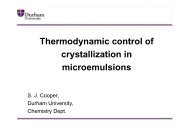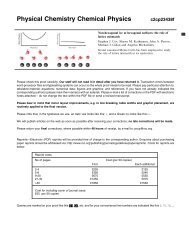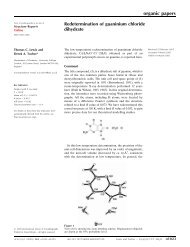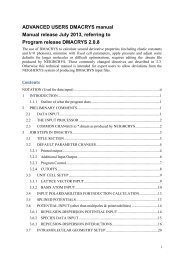An Introduction to the Theory of Crystalline Elemental Solids and ...
An Introduction to the Theory of Crystalline Elemental Solids and ...
An Introduction to the Theory of Crystalline Elemental Solids and ...
Create successful ePaper yourself
Turn your PDF publications into a flip-book with our unique Google optimized e-Paper software.
38<br />
7. Surface Electronic Structure<br />
Let’s now consider how <strong>the</strong> electronic structure at <strong>the</strong> surface differs from that in <strong>the</strong><br />
bulk. We have already seen for semiconduc<strong>to</strong>rs that <strong>the</strong> loss <strong>of</strong> translational symmetry<br />
along <strong>the</strong> surface normal has important consequences for <strong>the</strong> electronic structure, notably<br />
through <strong>the</strong> formation <strong>of</strong> dangling bonds which, as we have seen, have pr<strong>of</strong>ound implications<br />
for <strong>the</strong> surface structures that form. Now we focus on <strong>the</strong> electronic structures<br />
<strong>of</strong> metal surfaces <strong>and</strong> take this as an opportunity <strong>to</strong> discuss important concepts such<br />
as <strong>the</strong> surface dipole, <strong>the</strong> work function, surface core level shifts, <strong>and</strong> surface states.<br />
First we look at <strong>the</strong> surfaces <strong>of</strong> simple metals, where we find that again jellium provides<br />
useful insight, we <strong>the</strong>n move on <strong>to</strong> <strong>the</strong> transition metals <strong>and</strong> tight binding arguments.<br />
7.1 Jellium Surfaces: Electron overspill; Surface Dipole; <strong>and</strong> Φ<br />
Take <strong>the</strong> jellium model that we introduced earlier for <strong>the</strong> infinite crystal <strong>and</strong> terminate<br />
<strong>the</strong> positive background (n + ) abruptly along a plane at z = 0, with <strong>the</strong> positive uniform<br />
background now filling <strong>the</strong> half-space z ≤ 0 with <strong>the</strong> form:<br />
n + (z) = n, z ≤ 0<br />
= 0, z > 0 (35)<br />
where n is <strong>the</strong> mean density <strong>of</strong> <strong>the</strong> positive charge in <strong>the</strong> ionic lattice. For a range <strong>of</strong><br />
densities (r s = 2 − 6) Lang <strong>and</strong> Kohn [148, 149] considered how <strong>the</strong> density (within <strong>the</strong><br />
LDA) would behave at such an interface. The now famous plot displayed in Fig. 19(a)<br />
was obtained, which shows that: (i) <strong>the</strong> electron density spills in<strong>to</strong> <strong>the</strong> vacuum; <strong>and</strong><br />
(ii) <strong>the</strong> density within <strong>the</strong> boundary oscillates in a Friedel manner with an amplitude<br />
that decreases asymp<strong>to</strong>tically with <strong>the</strong> square <strong>of</strong> <strong>the</strong> distance from <strong>the</strong> surface. The<br />
characteristic wavelength is one half <strong>of</strong> <strong>the</strong> Fermi wavelength, k F , where k F = (3π 2 n) 1/3<br />
[150]. The amount <strong>of</strong> overspill in<strong>to</strong> <strong>the</strong> vacuum <strong>and</strong> <strong>the</strong> amplitude <strong>of</strong> <strong>the</strong> Friedel<br />
oscillations depends on r s . The smaller r s is, <strong>the</strong> larger <strong>the</strong> overspill. The larger r s is, <strong>the</strong><br />
greater <strong>the</strong> amplitude <strong>of</strong> <strong>the</strong> oscillations.<br />
The potentials associated with such density distributions are sketched in Fig. 19(b). In<br />
particular <strong>the</strong> <strong>to</strong>tal effective (Kohn-Sham) potential, V eff , <strong>and</strong> <strong>the</strong> electrostatic potential,<br />
V es are plotted. The difference between <strong>the</strong>m is <strong>the</strong> exchange-correlation contribution <strong>to</strong><br />
<strong>the</strong> <strong>to</strong>tal effective potential which one can see comprises <strong>the</strong> largest part <strong>of</strong> V eff . This is<br />
generally true for low <strong>and</strong> intermediate densities. Two aspects <strong>of</strong> <strong>the</strong> potentials are worth<br />
commenting upon. First, as a result <strong>of</strong> <strong>the</strong> local-density approximation, V eff vanishes<br />
exponentially in<strong>to</strong> <strong>the</strong> vacuum. This asymp<strong>to</strong>tic behavior is not correct. Instead, since<br />
as an electron moves out <strong>of</strong> a metal surface its exchange-correlation hole stays behind,<br />
flattening out on <strong>the</strong> surface, <strong>the</strong> effective potential should follow an image-like form:<br />
V eff (z) ∼<br />
1<br />
4|z − z image |<br />
. (36)<br />
Here z image is <strong>the</strong> so-called image plane, which for many purposes is considered <strong>the</strong><br />
“effective surface plane” [116, 151]. For typical values <strong>of</strong> r s <strong>the</strong> image plane (from LDA<br />
predictions) <strong>of</strong> clean jellium surfaces resides about 2-3 Å <strong>to</strong> <strong>the</strong> vacuum side <strong>of</strong> <strong>the</strong>







